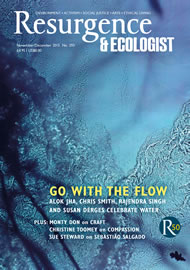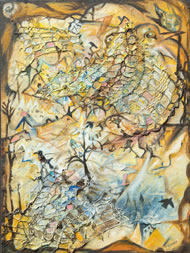Mary Barratt’s luminous, elaborately woven paintings and poems reveal a moving search to uncover what she calls “seed pearls” – or the Pearl of Great Price – at the heart of our lives. She is an extraordinary painter who should be much better known. There is a fierce Outsiderish quality as well as subtle artistry in her depictions of wild Nature and flaming cosmic landscapes. The intensity of her work has affinities with medieval stained glass, both in the taut structure of its labyrinthine binding lines and in the evocation of what mystics call “dazzling darkness”. But there is modernity too – and a prophetic voice casting light on the nature of contemporary society, with its tragic limitations as well as its magical potential – in her art in the recent tradition of visionary artists like David Jones, Cecil Collins and Greg Tricker.
Born near Mansfield in 1948, Barratt studied at Loughborough College of Art from 1966 to 1969, and then at Chelsea School of Art, yet she remains the most refreshingly intuitive and least academic of painters. She now lives in a village in Nottinghamshire.
Her poems and pictures exhibit transcendent tenderness for all creatures like “birds in their formation / [who] Describe unreachable beauty”, and for trees and plants such as “Moss, celandine and jewellery of glossy ivy ... wrapped around [Spring’s] loving hands”.
A short poem, Secrets, demonstrates the emblematic clarity and mysterious resonance of her writing at its best:
Some secrets to the grave are taken
In the unbending of the bow:
Arrows fired into the ground in silence
Then as starlit daisies in the earth can grow.
Her painting Beautiful Dawning, while retaining an original voice and vision, resembles the work of Kandinsky and Klee – the first artist in the fluid, almost hallucinogenic journeying through many dimensions of (and beyond) space and time, the second in its transfigured use of symbolic forms such as birds and trees to express deep realities far beyond conscious thought and everyday reasoning. Tiny dark birds soar and perch on a complex network of meandering black branches like curiously fragmented lead lines on a stained glass panel – but the painting’s ultimate expressive note is the much larger image of a bird’s head in full song emerging at top right.
In the beautiful new book of her poems and paintings, lines from a poem are set alongside this picture, helping elucidate its underlying mystical meaning as well as the transporting effects of its palette of yellow, gold and blue:
Sweet the lemon light
And fresh the chill of breaking dawn
Winning its way through the traitor’s heavy sleep.
But to each awakening thing the sound of diamonds
Thrown to the wind
From the chamber of a thrush’s throat –
As in her creatureliness she casts the hidden necklace
Into the sky.
Written by an artist who often skilfully multi-layers the painting surface with diverse materials, her poem Decoupage evokes the manifold meanings and resounding depths of both her paintings and her poetry:
And all is like decoupage, there for all to see –
Many, many layers of meaning,
Produced from the tree;
The pictures can be
Staggering, they go
Down, so very
Deep;
It’s best to view them in good light
– it’s that,
Which makes them sweet.
Mary Barratt’s work can been seen at the Cupola Gallery, Sheffield. www.cupolagallery.com. Mary Barratt Poems & Paintings is available from Blurb.







